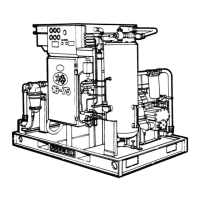Section 6
MAINTENANCE
32
6.8 TROUBLESHOOTING
The information contained in the Troubleshooting
chart has been compiled from field report data and
factory experience. It contains symptoms and usual
causes for the described problems, however DO
NOT assume that these are the only problems that
may occur. All available data concerning the trouble
should be systematically analyzed before undertak-
ing any repairs or component replacement proce-
dures.
A detailed visual inspection is worth performing for
almost all problems and may avoid unnecessary ad-
ditional damage to the compressor. Always remem-
ber to:
1. Check for loose wiring.
2. Check for damaged piping.
3. Check for parts damaged by head or an electrical
short circuit, usually apparent by discoloration or
a burnt order.
Should your problem persist after making the recom-
mended check, consult you nearest Sullair represen-
tative or the Sullair Corporation factory toll free at
1-800-348-2722.
TROUBLESHOOTING
SYMPTOM PROBABLE CAUSE REMEDY
Compressor will not start Main disconnect switch open Close switch.
Line fuse blown. Replace fuse.
Control transformer fuse blown Replace fuse.
Motor starter overloads tripped Reset. Should trouble persist, check
whether motor starter contacts are
functioning properly.
Low incoming line voltage Check voltage. Should voltage check low,
consult power company.
Compressor shuts down with
air demand present Loss of control voltage Reset. If trouble persists, check that line
pressure does not exceed maximum oper-
ating pressure of the compressor (specified
on nameplate).
Low incoming voltage Consult power company.
Excessive operating pressure Defect in pressure switch; check pressure
at which contact points open.
Separator requires maintenance; check
maintenance indicator under full load condi-
tions.
High pressure shutdown switch is adjusted
too low; readjust to 135 PSIG (931kPa).
Defective pilot valve; pilot valve should
cause control lever to move to unload stop
when the pressure switch contacts open.
Repair if defective.
Defective blowdown valve; blowdown valve
should exhaust sump pressure to 40 to
55 PSIG (276 to 379kPa) when maximum
operating pressure is reached. Repair if
defective.
Discharge temperature switch open Cooling water temperature too high;
increase water flow (water-cooled only).
Cooling water flow insufficient; check water
lines and valves (water-cooled only).
Cooler plugged; clean tubes. If plugging
persists, install water conditioner
(water-cooled only).
Cooling air flow restricted; clean cooler and
check for proper ventilation.
Ambient temperature is too high; provide
sufficient ventilation.
Low fluid level; add fluid.

